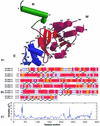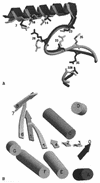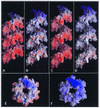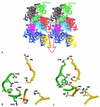Crystal structures of Mycobacterium tuberculosis RecA and its complex with ADP-AlF(4): implications for decreased ATPase activity and molecular aggregation
- PMID: 11121488
- PMCID: PMC115232
- DOI: 10.1093/nar/28.24.4964
Crystal structures of Mycobacterium tuberculosis RecA and its complex with ADP-AlF(4): implications for decreased ATPase activity and molecular aggregation
Abstract
Sequencing of the complete genome of Mycobacterium tuberculosis, combined with the rapidly increasing need to improve tuberculosis management through better drugs and vaccines, has initiated extensive research on several key proteins from the pathogen. RecA, a ubiquitous multifunctional protein, is a key component of the processes of homologous genetic recombination and DNA repair. Structural knowledge of MtRecA is imperative for a full understanding of both these activities and any ensuing application. The crystal structure of MtRecA, presented here, has six molecules in the unit cell forming a 6(1) helical filament with a deep groove capable of binding DNA. The observed weakening in the higher order aggregation of filaments into bundles may have implications for recombination in mycobacteria. The structure of the complex reveals the atomic interactions of ADP-AlF(4), an ATP analogue, with the P-loop-containing binding pocket. The structures explain reduced levels of interactions of MtRecA with ATP, despite sharing the same fold, topology and high sequence similarity with EcRecA. The formation of a helical filament with a deep groove appears to be an inherent property of MtRecA. The histidine in loop L1 appears to be positioned appropriately for DNA interaction.
Figures





Similar articles
-
Structural studies on MtRecA-nucleotide complexes: insights into DNA and nucleotide binding and the structural signature of NTP recognition.Proteins. 2003 Feb 15;50(3):474-85. doi: 10.1002/prot.10315. Proteins. 2003. PMID: 12557189
-
Comparison of bacteriophage T4 UvsX and human Rad51 filaments suggests that RecA-like polymers may have evolved independently.J Mol Biol. 2001 Oct 5;312(5):999-1009. doi: 10.1006/jmbi.2001.5025. J Mol Biol. 2001. PMID: 11580245
-
Functional characterization of the precursor and spliced forms of RecA protein of Mycobacterium tuberculosis.Biochemistry. 1996 Feb 13;35(6):1793-802. doi: 10.1021/bi9517751. Biochemistry. 1996. PMID: 8639660
-
The bacterial RecA protein and the recombinational DNA repair of stalled replication forks.Annu Rev Biochem. 2002;71:71-100. doi: 10.1146/annurev.biochem.71.083101.133940. Epub 2001 Nov 9. Annu Rev Biochem. 2002. PMID: 12045091 Review.
-
Structure and mechanism of Escherichia coli RecA ATPase.Mol Microbiol. 2005 Oct;58(2):358-66. doi: 10.1111/j.1365-2958.2005.04876.x. Mol Microbiol. 2005. PMID: 16194225 Review.
Cited by
-
Expression, purification, crystallization and preliminary X-ray crystallographic analysis of pantothenate kinase from Mycobacterium tuberculosis.Acta Crystallogr Sect F Struct Biol Cryst Commun. 2005 Jan 1;61(Pt 1):65-7. doi: 10.1107/S1744309104028040. Epub 2004 Nov 9. Acta Crystallogr Sect F Struct Biol Cryst Commun. 2005. PMID: 16508093 Free PMC article.
-
RecX protein abrogates ATP hydrolysis and strand exchange promoted by RecA: insights into negative regulation of homologous recombination.Proc Natl Acad Sci U S A. 2002 Sep 17;99(19):12091-6. doi: 10.1073/pnas.192178999. Epub 2002 Sep 6. Proc Natl Acad Sci U S A. 2002. PMID: 12218174 Free PMC article.
-
A human XRCC4-XLF complex bridges DNA.Nucleic Acids Res. 2012 Feb;40(4):1868-78. doi: 10.1093/nar/gks022. Epub 2012 Jan 27. Nucleic Acids Res. 2012. PMID: 22287571 Free PMC article.
-
Myxococcus xanthus translesion DNA synthesis protein ImuA is an ATPase enhanced by DNA.Protein Sci. 2024 May;33(5):e4981. doi: 10.1002/pro.4981. Protein Sci. 2024. PMID: 38591662 Free PMC article.
-
Full-length archaeal Rad51 structure and mutants: mechanisms for RAD51 assembly and control by BRCA2.EMBO J. 2003 Sep 1;22(17):4566-76. doi: 10.1093/emboj/cdg429. EMBO J. 2003. PMID: 12941707 Free PMC article.
References
-
- Snider D.E. Jr, Raviglione,M. and Kochi,A. (1994) In Bloom,B.R. (ed.), Tuberculosis: Pathogenesis, Protection and Control. American Society for Microbiology, Washington, DC, pp. 2–11.
-
- Vaze M.B. and Muniyappa,K. (1999) RecA protein of Mycobacterium tuberculosis possesses pH-dependent homologous DNA pairing and strand exchange activities: implications for allele exchange in mycobacteria. Biochemistry, 38, 3175–3186. - PubMed
-
- Roca A.I. and Cox,M.M. (1997) RecA protein: structure, function and role in recombinational DNA repair. Prog. Nucleic Acid Res. Mol. Biol., 56, 129–223. - PubMed
Publication types
MeSH terms
Substances
Grants and funding
LinkOut - more resources
Full Text Sources
Other Literature Sources
Molecular Biology Databases

